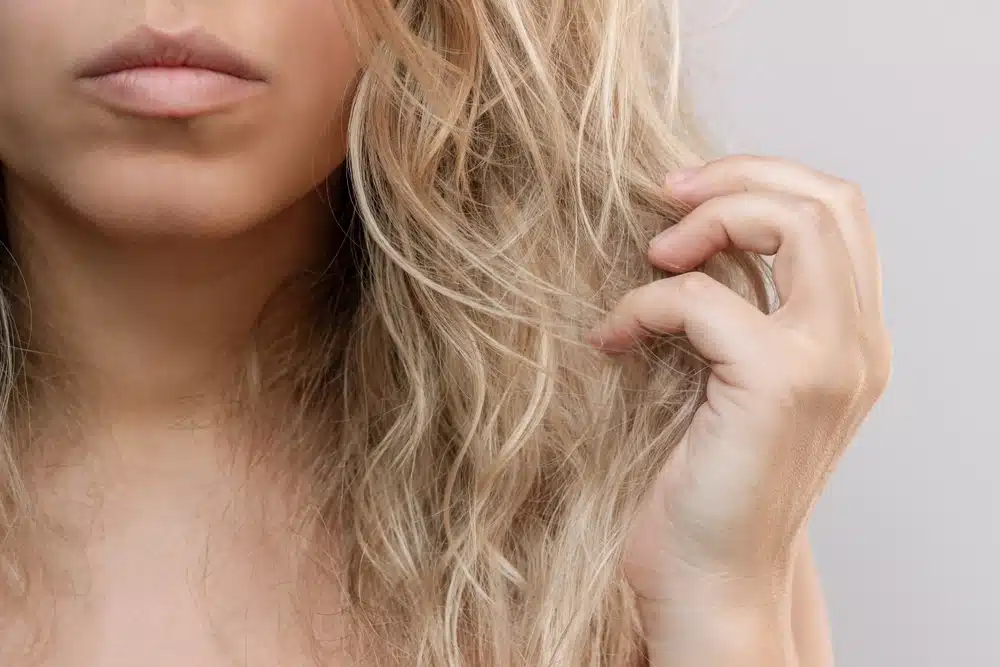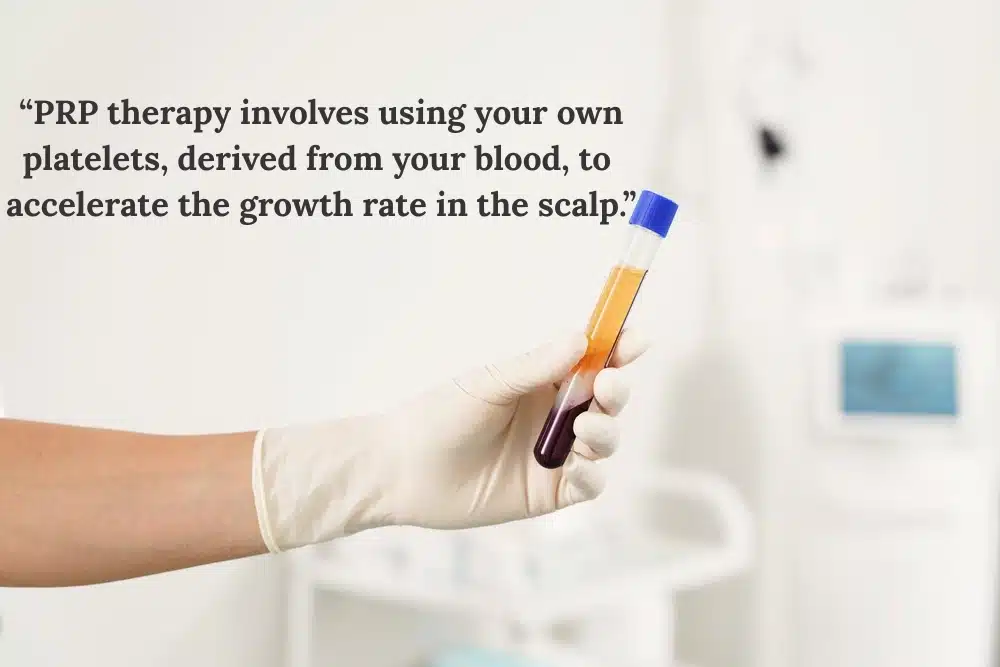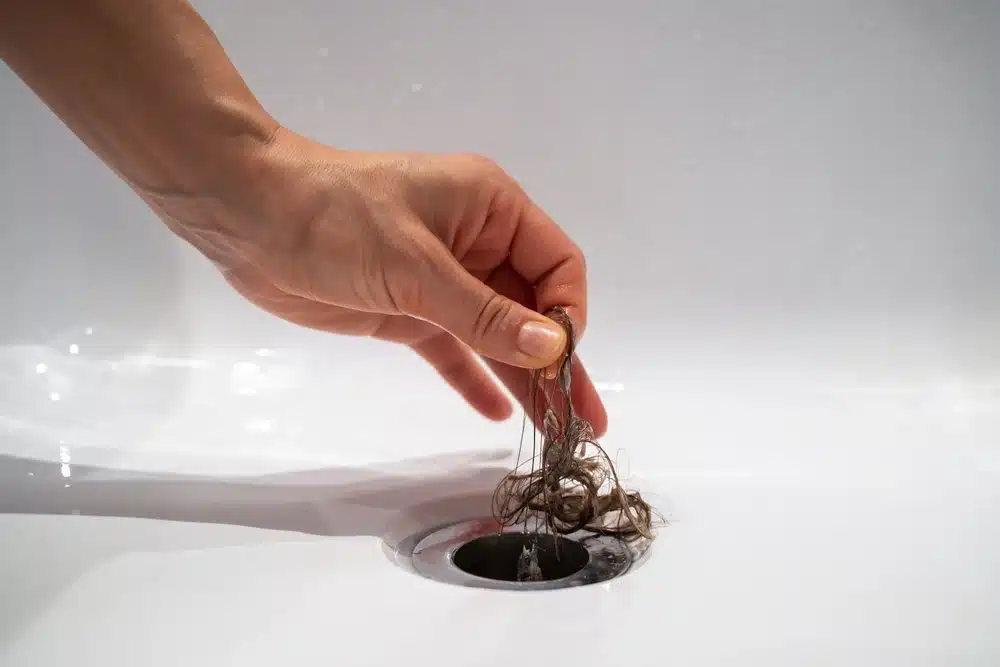Hair is susceptible to damage. Whether you’re brushing out knots, using harsh shampoos, applying heat to your hair, or bleaching it, your styling methods may be causing more problems than they’re solving.
One of the most damaging treatments for hair is bleach. Despite the potential for serious damage, people still seek out bleaching treatments to lighten their hair, often only worrying about the damage that has already occurred.
So, what is bleach damaged hair, and are there ways to treat it? In this guide, find out the causes, symptoms, and treatment options for bleach-damaged hair.
Bleaching Hair: What it Does
Bleach is a chemical substance often used in cleaning products, although it is also commonly used as a hair treatment. When used on the hair, it creates a chemical process that lightens the locks by removing any pigment. [1] Often, this results in a light blonde colour, although the outcome varies depending on the individual’s starting hair colour.
In most cases, bleach is necessary to achieve the blonde look. Of course, there are different levels of bleaching the hair – some are more damaging than others.
Why Does Bleach Damage Hair?
The bleaching process is extremely harsh on the strands and actively damages the structure of the hair’s fibres. It strips the hair of its natural oils, weakens the bids, and dries the hair out. All of this leads to dry, damaged hair prone to split ends and breakage. In some cases, the bleach can also irritate the scalp.
The Causes of Bleach Damaged Hair
Bleach damaged hair happens very easily; here are some of the main causes.
Bleaching Too Often: Bleaching your hair too often means it’s more likely to sustain damage. Most hairdressers recommend leaving at least 6 weeks between treatments.
Leaving Bleach On Too Long: Leaving a hair dye with bleach in your hair too long means that there will be more damage, as the bleach has more chance to penetrate and dry out the hair strands.
Trying to Lighten Hair Too Much: It’s far harder to attain a light blonde hair colour if you have very dark hair. Those who try to go from black or dark brown to blonde in a single hair dye session are more likely to experience damaged hair.
The Signs of Bleach Damaged Hair
You might wonder, how do I know if my bleached hair is damaged? Worried you need to fix bleached hair? Here are the signs to watch out for.
- Dullness
- A Lack of Shine
- Very Dry Hair
- Brittle Strands
- Breakage
- Split Ends
- Flyaways
- Tangling
- Loss of Elasticity
- Hair Shedding
- Straw-Like Hair
If you experience any of these signs of bleach damage after treating your hair, it is time to step away from the hair dye and focus more on nourishing your strands. That way, you can achieve healthy-looking hair once more.
How Long Does Bleach Damaged Hair Take to Repair?
It is hard to say how long bleach damaged hair takes to repair. This chemical processing does a lot of damage to your hair shaft, after all. Slightly damaged hair from bleach may take just a few weeks to look healthy again, whereas very damaged bleached hair might require much more time, perhaps even for a full regrowth.
How to Fix Damaged Bleached Hair: The Best Methods
Have you realised you have experienced damage from bleach and want to protect your hair going forward? It’s never too late to look after your locks. Here are some of the best methods for to fix bleach damaged hair.
Lots of Conditioner
Conditioner is a way to deeply nourish your strands. So, if you have bleach damaged hair, conditioner should become your very best friend! Invest in a good conditioner – one that offers plenty of moisture – and use it every time you get in the shower. You should also invest in a deep conditioner to use once a week. If your hair is particularly dry and tangled, consider using a leave-in conditioner that can help keep your hair moisturized after washing.
Wear a Protective Hairstyle
You want to avoid having your hair sustain any more damage, and one way to do that is wearing a protective hairstyle. Loose brains are particularly good for this, as they reduce the amount of friction on your hair, meaning it is less likely to break.
Shampoo Less Often
While you may be accustomed to washing your hair with shampoo and conditioner every day or every other day, it’s beneficial to reduce the frequency if you have sustained damage. The reason is that shampoo can dry out your hair even further when used too often, as it washes away your natural oils.
Be Gentle
Avoid being too rough when styling your hair! Be as gentle as you can. Brush slowly, using a high-quality hairbrush that doesn’t pull too much. You should also use a gentle shampoo to prevent it from stripping your hair too much.
Avoid the Heat
One way to increase the amount of damage to your hair is by using too much heat. Heat will only worsen your strands, so avoid it at all costs. Do not blow dry; instead, air dry your strands where you can. When you need to use heat styling hot tools, always use a heat protection spray.
Trim Your Hair
It’s challenging to maintain healthy hair if you never trim it, and this is especially true for bleach-damaged hair. The more you trim your hair, the less likely you are to have bleach-damaged hair, so trim it as much as possible.
If you want to take it a step further, it might be worth opting for a more drastic cut, especially if your hair is severely damaged. This gives your hair a fresh start – a chance to grow out without any damage.
Use a Silk Pillowcase
Did you know the material of your pillow influences the health of your hair? It’s true – certain materials can worsen your hair damage. The best material for healthy hair is silk, as it is smoother and causes less friction. [2] It is a small change that can make a world of difference. Plus, a silk pillowcase can even reduce wrinkles, so there’s an added bonus!
Avoid Bleach
You don’t want to have to start the cycle all over again, so avoid the bleach from now on, especially if you are prone to breakage. In some cases, avoiding bleach for a couple of months should be enough to give your hair the chance to repair – in others, it might be best to opt for a darker hair dye going forward.
Monitor Your Hair
Keep an eye on your hair from now on, avoiding damage if your hair looks like it needs some rest. You can invest in a hair track app to monitor how it is doing.
Can Bleach Cause Hair Loss?
Yes, bleach can actually cause hair loss.
The first (and most likely) way bleach causes hair loss is through breakage. The bleach damages the hair shaft, which can lead to the hair becoming weaker and breaking off. This means experiencing temporary hair loss at the strands rather than at the root.
In rarer cases, chemical alopecia can occur, which is when the bleach impacts the hair follicles and causes more permanent hair loss. In this case, a hair loss treatment is necessary.
Treating Hair Loss
Treating hair loss extends beyond improving your hair care game. The good news is there are ways to treat a chemically damaged scalp to help restore a full head of hair once more.
Minoxidil: Minoxidil is a hair loss medication used by men and women to restore hair growth. It is typically applied topically daily and takes approximately three months for results to become visible. You do not need a prescription to obtain minoxidil – it is available over the counter under the brand name Rogaine.
Topical Steroids: Topical corticosteroids can be helpful for promoting new growth by reducing inflammation. If you have chemical alopecia, speak to your doctor about this treatment.
Low-Level Light Therapy: This is a common type of therapy that uses low-level lights to stimulate the hair follicles and encourage growth. It’s minimally invasive and can make a big difference.
Platelet-Rich Plasma Therapy: PRP therapy involves using your own platelets, derived from your blood, to accelerate the growth rate in the scalp. It’s a minimally invasive procedure that can drastically promote hair growth in some people.
Hair Transplant: Arguably the best way to treat hair loss is with a hair transplant. A hair transplant involves a surgeon extracting follicles from the donor area of the scalp and implanting them into the balding area. This treatment is best for those who have experienced permanent hair loss.
Final Thoughts
Nobody wants to deal with bleach damaged hair. It increases dryness, reduces shine, and potentially leads to breakage and hair loss. The good news is there are preventative measures to avoid bleach damage, as well as ways to repair the hair, whether through hair masks or conditioning treatments.
Have you experienced permanent hair loss? If so, consider getting a hair transplant, a minimally invasive surgery that provides long-lasting results. Check our patients gallery to see what hair transplants have already been done for others!
Sources:
- https://www.webmd.com/beauty/what-to-know-about-hair-bleach
- https://www.womenshealthmag.com/beauty/a19996004/silk-pillowcase-for-hair/





